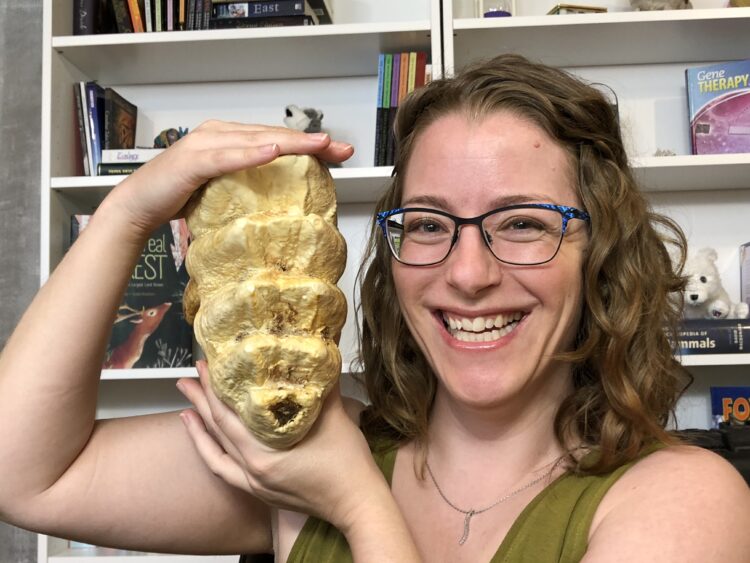 |
| A mastodon molar is AS BIG AS MY HEAD, y'all. |
Did you have a dinosaur phase when you were a kid? I did. I was in the second grade, and I was obsessed. I pored over library books, memorizing five-syllable names and amazing the adults with my stockpile of bizarre dino facts (I still do that). I liked the armoured species best, because they were just so weird.
And then my parents took me to the Royal Tyrrell Museum to see real fossils.
Mind. Blown.
Looking back, I can see how these early experiences helped spark my life-long obsession, not just with dinosaurs, but with all life on Earth. But not every child has opportunities to visit natural history museums, either with their families or on school field trips. That's why, when Dr. Lynda Colgan asked me to write the teacher's guides for her Learning with Palaeontology project, I jumped at the chance.
(Also, I'm pretty sure that all children's science writers are legally-obligated to write about dinosaurs at least once in their careers, so box checked!)
As with most of Lynda's ideas, this one was both simple and profound. First, we'd get some great big boxes. Next, we'd fill them with museum quality casts of real fossils, providing teacher's guides that provided the latest scientific knowledge about the species, while focusing on inquiry and hands-on learning. And then, we'd make the kits available to teachers for free.
 |
| And giant beavers? They were as big as black bears. I mean, how cool is THAT? |
The first two Kits, on the Pleistocene Extinction, are now available to borrow. Teacher-friends, here's what you need to know:
Features of the Kits
- Fossil casts of mammals that lived in Canada during the Pleistocene
- Supporting materials such as magnifying glasses, graphs, and charts
- Teacher’s Guide containing
- ALL the information needed to teach core concepts
- Suggestions for hands-on learning and independent inquiry
- Glossary, further reading lists, and bibliography of sources
- Content vetted by experts in palaeontology, education, science communication, and Indigenous issues
Core Concepts and Skills
Junior Edition - Best for Grades 4-7
- Habitat
- Evolution and adaptations
- Biodiversity and classification systems
- Food chains and energy pyramids
- Competition and predator/prey interactions
- Climate change
- Extinction
Senior Edition - Best for Grades 8-12
- Habitat and geographic range
- Evolution and adaptations
- Competition and predator/prey interactions
- Trophic cascades
- Heredity and ancient DNA
- Climate change
- Extinction
- De-extinction: biotechnology and bioethics
- Correlation vs. causation
At both levels, students will:
- Evaluate sources of information and assess their strengths and weaknesses
- Draw conclusions using multiple lines of evidence
- Understand the relevance of palaeontology to urgent contemporary issues
 |
| Junior/Elementary Kit |
Borrowing Instructions:
Are you in Ontario? You're in luck! Head on over to the Queen's University Education Library catalogue and place a hold on a physical kit. The cases are on wheels, but they weigh about 40 pounds, so I recommend bringing a friend and a vehicle with a big trunk.
Not in Ontario? Don't worry, we have got you covered. Each Kit is also available in a digital edition, complete with 3D scans of the fossils that you can manipulate from your web browser. Direct links are here:
Junior/Elementary Level
The Pleistocene: Using Ice Age Mammals to Explore Climate, Habitat, and Extinction
Senior/High School Level
Conservation Palaeontology: Using Ice Age Mammals to Explore Climate Change and Extinction
Again, these resources are available to Canadian teachers absolutely free. I field tested them at some student workshops during Science Rendezvous in May, and I can guarantee your kids will be spellbound. I was beyond delighted at the level of critical thinking and curiosity my groups displayed while interacting with the fossils, and I can't wait to hear similar stories from classrooms across the country.
I also cannot wait to launch the new Kits we've been developing this year. Stay tuned, and keep exploring!
The Learning With Palaeontology Project is supported by:



with graphic design by:

No comments:
Post a Comment